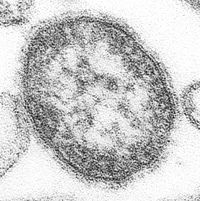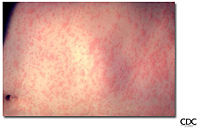Measles
| [[Image:{{{Image}}}|190px|center|]] | |
|---|---|
| ICD-10 | B05.- |
| ICD-O: | {{{ICDO}}} |
| ICD-9 | 055 |
| OMIM | {{{OMIM}}} |
| MedlinePlus | {{{MedlinePlus}}} |
| eMedicine | {{{eMedicineSubj}}}/{{{eMedicineTopic}}} |
| DiseasesDB | {{{DiseasesDB}}} |
| Measles virus | ||||||||
|---|---|---|---|---|---|---|---|---|
 Measles virus | ||||||||
| Virus classification | ||||||||
Template:Taxobox goup v entry
|
Measles, also known as rubeola, is a disease caused by a virus of the genus Morbillivirus.
Reports of measles go back to at least 600 B.C.E., however, the first scientific description of the disease and its distinction from smallpox is attributed to the Persian physician Ibn Razi (Rhazes) 860-932 who published a book entitled "Smallpox and Measles" (in Arabic: Kitab fi al-jadari wa-al-hasbah). In 1954, the virus causing the disease was isolated, and licensed vaccines to prevent the disease became available in 1963.
Measles is spread through respiration (contact with fluids from an infected person's nose and mouth, either directly or through aerosol transmission), and is highly contagious—90% of people without immunity sharing a house with an infected person will catch it. Airborne precautions should be taken for all suspected cases of measles.
The incubation period usually lasts for 10-12 days (during which there are no symptoms).
Infected people remain contagious from the appearance of the first symptoms until 3-5 days after the rash appears.
Symptoms
The classical symptoms of measles include a fever for at least three days, and the three Cs—cough, coryza (runny nose) and conjunctivitis (red eyes). The fever may reach up to 40 degrees Celsius (105 Fahrenheit). Koplik's spots seen inside the mouth are pathognomic (diagnostic) for measles but are not often seen, even in real cases of measles, because they are transient and may disappear within a day of arising.
The rash in measles is classically described as a generalised, maculopapular, erythematous rash that begins several days after the fever starts. It starts on the head before spreading to cover most of the body. The measles rash also classically "stains" by changing colour to dark brown from red before disappearing later. The rash can be itchy.
Diagnosis
A detailed history should be taken including course of the disease so far, vaccination history, contact history, and travel history.
Clinical diagnosis of measles requires a history of fever of at least three days together with at least one of the three Cs. Observation of Koplik's spots is also diagnostic of measles.
Alternatively, laboratory diagnosis of measles can be done with confirmation of positive measles IgM antibodies or isolation of measles virus RNA from respiratory specimens.
Positive contact with other patients known to have measles adds strong epidemiological evidence to the diagnosis.
Treatment
There is no specific treatment for uncomplicated measles. Most patients with uncomplicated measles will recover with rest and supportive treatment.
Complications
Complications with measles are relatively common, ranging from relatively common and less serious diarrhea, to pneumonia and encephalitis (subacute sclerosing panencephalitis). Complications are usually more severe amongst adults who catch the virus.
The fatality rate from measles for otherwise healthy people in developed countries is low: approximately 1 death per thousand cases. In underdeveloped nations with high rates of malnutrition and poor healthcare, fatality rates of 10 percent are common. In immunocompromised patients, the fatality rate is approximately 30 percent. Measles is estimated to kill 674,000 people in developing countries annually.[1]
Public health
In developed countries, most children are immunised against measles at the age of 18 months, generally as part of a three-part MMR vaccine (measles, mumps, and rubella). The vaccination is generally not given earlier than this because children younger than 18 months usually retain anti-measles immunoglobulins (antibodies) transmitted from the mother during pregnancy. A "booster" vaccine is then given between the ages of four and five. Vaccination rates have been high enough to make measles relatively uncommon. Even a single case in a college dormitory or similar setting is often met with a local vaccination program, in case any of the people exposed are not already immune. In developing countries, measles remains common.
The recent vaccine controversy in the United Kingdom regarding a potential link between the combined MMR vaccine (vaccinating children from mumps, measles and rubella) and autism has prompted a resurgence in popularity of the "measles party", where parents deliberately infect the child with measles in order to build up the child's immunity without requiring an injection. This practice poses many health risks to the child, and has been discouraged by the National Health Service.[1]
Measles is a significant infectious disease because, while the rate of complications is not high, the disease itself is so infectious that the sheer number of people who would suffer complications in an outbreak amongst non-immune people would quickly overwhelm available hospital resources. If vaccination rates fall, the number of non-immune persons in the community rises, and the risk of an outbreak of measles consequently rises.
According to the World Health Organization (WHO), measles is a leading cause of vaccine preventable childhood mortality—there were 30 million cases and 875,000 deaths caused by measles every year.[2] The WHO and the United Nations Children's Fund (UNICEF) reports that the global immunization drive has cut measles deaths by nearly half between 1999 and 2004 (from 871,000 in 1999 to an estimated 454,000 in 2004), "thanks to major national immunization activities and better access to routine childhood immunization".[3]
MMR Eradication
(Not to be confused with the World Health Organization's Measles Initiative)
In the 1990s, the governments of America, along with the Pan American Health Organization, launched a plan to eradicate Measles, Mumps, and Rubella from the region.
Indigenous measles has been eliminated in North, Central, and South America; the last endemic case in the region was reported on November 12, 2002. [2]
Outbreaks are still occuring, however, following importations of measles viruses from other world regions. (There is currently an outbreak in Boston which resulted from a Boston resident who recently visited India. [3] This outbreak, including the 10 index cases, is described extensively in an NPR report [4].)
There are also plans underway to eliminate Rubella from the region by 2010 [5]. As of 2006, endemic cases were still being reported in Bolivia, Brazil, Colombia, Guatemala, Mexico, Peru, and Venezuela.
While some smaller organizations have proposed a global MMR eradication [6], none is likely to take place until, at least, after the worldwide eradication of Poliomyelitis.
See also
- MMR vaccine for details on the vaccine and associated controversy
ReferencesISBN links support NWE through referral fees
- ↑ MMR the facts: MMR basics - What about homeopathic alternatives?
- ↑ World Health Organization & United Nations Children’s Fund "Measles, Mortality Reduction and Regional Elimination - Strategic Plan 2001–2005" PDF
- ↑ WHO/UNICEF "Global measles deaths plunge by 48% over past six years" 10 March 2006 Joint News Release
External links
- WHO.int - 'Initiative for Vaccine Research (IVR): Measles', World Health Organization (WHO)
| Exanthema edit |
| Measles (1st disease) - Scarlet fever (2nd disease) - Rubella (3rd disease) Duke's disease (4th disease) - Slap cheek (5th disease) - Roseola (6th disease) |
Credits
New World Encyclopedia writers and editors rewrote and completed the Wikipedia article in accordance with New World Encyclopedia standards. This article abides by terms of the Creative Commons CC-by-sa 3.0 License (CC-by-sa), which may be used and disseminated with proper attribution. Credit is due under the terms of this license that can reference both the New World Encyclopedia contributors and the selfless volunteer contributors of the Wikimedia Foundation. To cite this article click here for a list of acceptable citing formats.The history of earlier contributions by wikipedians is accessible to researchers here:
The history of this article since it was imported to New World Encyclopedia:
Note: Some restrictions may apply to use of individual images which are separately licensed.
